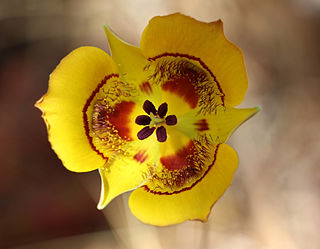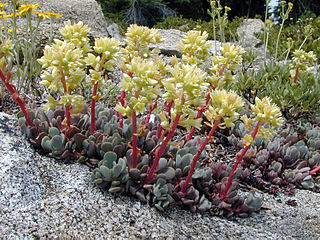
Eriophyllum lanatum, with the common names common woolly sunflower and Oregon sunshine, is a common, widespread, North American plant in the sunflower family.

Cupressus arizonica, the Arizona cypress, is a North American species of tree in the cypress family Cupressaceae, native to the southwestern United States and Mexico. Populations may be scattered rather than in large, dense stands.

Prunus subcordata, known by the common names Klamath plum, Oregon plum, Pacific plum and Sierra plum, is a member of the genus Prunus, native to the western United States in California and western and southern Oregon. It grows in forests, most often at low elevation near the coast, but it is also in the Sierra Nevada and Cascades; it grows at elevations of 100–1,900 m. P. subcordata var. subcordata, Klamath plum, is also found in Washington.

Salix lasiolepis is a species of willow native to western North America.

Allium obtusum is a species of wild onion known by the common name red Sierra onion or subalpine onion. It is native to eastern California and western Nevada. It is a common plant in the granite foothills and mountains of the Sierra Nevada and southern Cascade Range, from Tulare County to Siskiyou County, from elevations of 800 to 3,500 metres. In Nevada, it is reported only from Washoe County in the northwestern part of the state.

Calochortus clavatus is a species of mariposa lily known by the common name clubhair mariposa lily. It is endemic to California where it is found in forests and on chaparral slopes.

Quercus vacciniifolia, the huckleberry oak, is a member of the Protobalanus section of genus Quercus. It has evergreen foliage, short styles, very bitter acorns that mature in 18 months, and a woolly acorn shell interior.

Sambucus racemosa is a species of elderberry known by the common names red elderberry and red-berried elder.

Diplacus jepsonii, formerly classified as Mimulus nanus var. jepsonii, is a species of monkeyflower known by the common name Jepson's monkeyflower.
Monardella linoides is a species of flowering plant in the mint family known by the common name flaxleaf monardella.

Psorothamnus arborescens is a species of flowering plant in the legume family known by the common name Mojave indigo bush.

Ranunculus eschscholtzii is a species of buttercup flower known by the common name Eschscholtz's buttercup.
Sedum albomarginatum is a rare species of flowering plant in the family Crassulaceae known by the common name Feather River stonecrop. It is endemic to California where it is known from fewer than 20 occurrences along the Feather River in Plumas and Butte Counties. It grows on steep cliffs and mountain slopes in rocky serpentine substrates.
Sedum niveum is a species of flowering plant in the family Crassulaceae known by the common name Davidson's stonecrop. It is native to southern California and northern Baja California, where it is known from several local mountain ranges. It grows in rocky, forested habitat. It is a succulent plant forming basal mats of spoon-shaped or oval leaves no more than a centimeter long. The small inflorescence grows up to 9 centimeters tall and bears several flowers with white petals tinged or veined with pink. The stamens have red or black anthers.
Sedum oblanceolatum is a species of flowering plant in the family Crassulaceae known by the common names oblongleaf stonecrop and Applegate stonecrop. It is native to the Klamath Mountains of southwestern Oregon and far northern California, where it grows on many types of rocky substrate, such as serpentine soils and other ultramafics. It is a succulent plant forming basal rosettes of waxy leaves. The leaves are widely lance-shaped, widest near the distal end and narrowing to rounded or notched tips. Smaller leaves occur farther up the stem. The small inflorescence grows a few centimeters tall and bears up to 50 flowers in a flat-topped array. The flowers have cream or yellowish petals up to a centimeter long.

Sedum oregonense is a species of flowering plant in the family Crassulaceae known by the common name cream stonecrop. It is native to the Klamath Ranges of southern Oregon and northern California, where it grows in rocky habitat. It is a succulent plant forming basal rosettes of leaves up to about 4 centimeters long. Smaller leaves occur farther up the stem. The leaves are green in color and waxy in texture. The inflorescence is an erect, wide open array of many flowers. The flowers have yellow petals with red-tinged or white-speckled undersides.
Sedum radiatum is a species of flowering plant in the family Crassulaceae known by the common name Coast Range stonecrop. It is native to Oregon and California, where it is known from several coastal and inland mountain ranges, including the Klamath Mountains and the Sierra Nevada. It grows in many types of rocky habitat, sometimes on serpentine soils. It is an annual or biennial succulent plant producing several stems with elevated, somewhat basal rosettes of leaves. The leaves are not much more than a centimeter long. They are green or yellowish with green, purple or red veining. The inflorescence is a short, erect array of many densely packed flowers. The flowers have yellow, cream, or white petals which are lance-shaped and one half to 1 centimeter long.

Sedum spathulifolium is a species of flowering plant in the family Crassulaceae known by the common names broadleaf stonecrop, yellow stonecrop, and Colorado stonecrop. An evergreen perennial, it is native to western North America from British Columbia to southern California, where it can be found often in shade in many types of rocky habitat in coastal and inland hills and mountains.

Sidalcea oregana is a species of flowering plant in the mallow family known by the common name Oregon checkerbloom.














